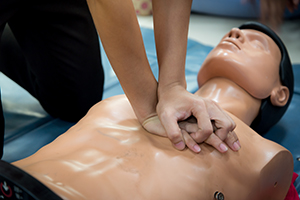Bystander CPR May Make the Difference In Saving a Life
During the first quarter of a Monday Night Football game on Jan. 2, Buffalo Bills player Damar Hamlin collapsed on the field after making a tackle. Hamlin “suffered a cardiac arrest following a hit in our game versus the Bengals. His heartbeat was restored on the field and he was transferred to the UC Medical Center for further testing and treatment,” according to his team. In a week, Hamlin went from being sedated on a ventilator to sitting up in his hospital bed, cheering on his team. The next day he was released from the UC Medical Center to travel home to a Buffalo hospital to continue his recovery and identify any possible causes of the cardiac arrest, according to the Buffalo Bills. He was discharged from the hospital on Jan. 11.
Hamlin’s story serves as a good reminder for all of us to know what to do if anyone collapses and needs life-saving care. The team’s assistant athletic trainer Denny Kellington was on the field moments after Hamlin collapsed, giving CPR and chest compressions.
Call-Push-Shock
CPR, especially if performed immediately, can double or triple a cardiac arrest victim’s chance of survival. Follow these three simple steps to help a friend, family member or any individual in distress:
- Call 911.
- Push – Find the center of the individual’s chest and give 100 to 120 chest compressions per minute.
- Shock the individual using an AED (if available).
Starting bystander CPR before emergency personal responds can help improve survival rates. Emergency personnel responding to your call should have an AED with them. Depending on where you are, many schools and other community buildings may have an AED present. In 2019, a CentraCare physician went into sudden cardiac arrest at the St. Cloud Area Family Y and several nurses were able to revive him with an on-site AED.
You can find outdoor AED units that are accessible 24/7 in several Central Minnesota cities. Find one near you.
You should follow the Call, Push, Shock instructions above for anyone needing CPR who is older than 4 months of age. Even if you are not trained or certified in CPR, following these instructions and giving chest compressions could help a person in need.
Close to 90% of cardiac arrest occur in homes and public settings. They happen where we live, work and play. Learning bystander CPR can make the difference between life and death!
